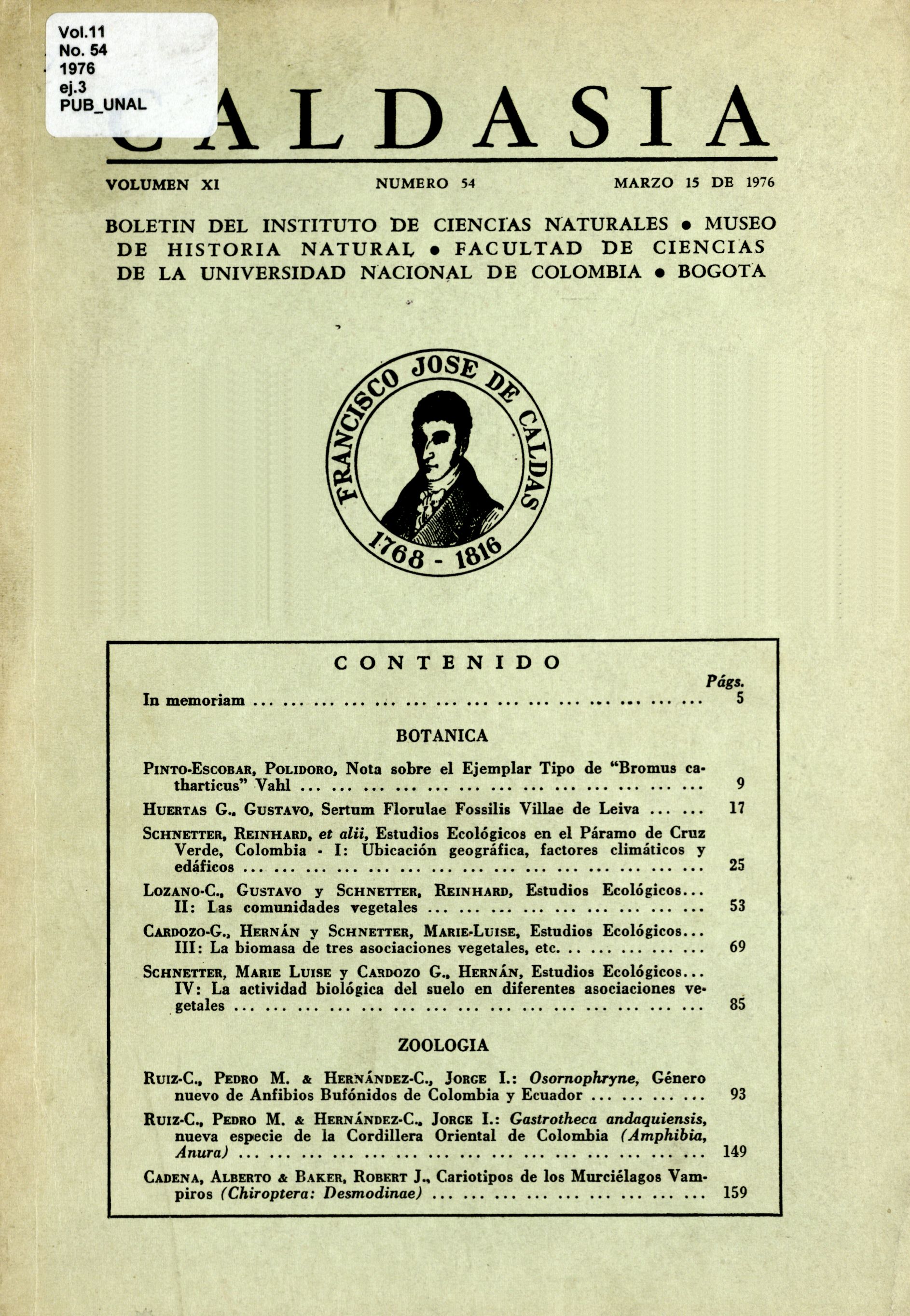Estudios ecológicos en el Páramo de Cruz Verde, Colombia. III. La biomasa de tres asociaciones vegetales y la productividad de Calamagrostis Effusa (H. B. K.) Steud. Y Paepalanthus Columbiensis Ruhl. En comparación con la concentración de Clorofila
Keywords:
Estudios ecológicos, Calamagrostis Effusa (H. B. K.), Steud, Paepalanthus Columbiensis Ruhl (es)Estudios ecológicos, Calamagrostis Effusa (H. B. K.), Steud, Paepalanthus Columbiensis Ruhl (de)
Downloads
La asociación de Calamagrostis effusa, Espeletia grandiflora y Geranium santanderiense mostró la mayor biomosa aérea, ocasionada por el mayor porcentaje de plantas leñosas en la vegetación. En segundo lugar siguió la asociación degradada de Diplostephium revolutum, pero con valores claramente inferiores. Aquí se destacó la considerable cantidad de
musgos. Los valores menores se encontraron en la asociación de Calamagrostis effusa y Altesteinia fimbriata. La mayor biomasa subterránea se obtuvo en la asociación degradada de Diplostephium revolutum, mientras en las dos asociaciones restantes sólo se determinó poco más de la mitad
de la cantidad hallada en el terreno húmedo. Transcurrido un año no se pudo comprobar un cambio en el peso seco de Calamagrostis y Paepalanthus, así que la producción neta fue nula durante el período de la investigación. De octubre a enero se observó en Calamagrostis una disminución del contenido de clorofila en las asociaciones de Calamagrostis effusa y Altesteinia fimbriata y de Calamagrostis effusa, Espeletia grandiflora y Geranium santanderiense. La determinación del material seco de Calamagrostis y Paepalanthus, crecido sobre parcelas previamente cosechadas, dio por resultado un mejor
poder de regeneración para Calamagrostis. Pero en el lapso de nueve meses creció como máximo solo una tercera parte de la cantidad inicialmente presente.
und des Chlorophyllgehaltes von Calamagrostis effusa und Paepalanthus columbiensis durchgeführt. Die Calamagrostis effusa - Espeletia grandiflora - Geranium santanderiense
- Geselischaft wies die gröBte oberirdische Biomasse auf, was auf den groBen Anteil an Holzpflanzen in der Vegetation zurückzuführen ist. An zweiter Stelle, aber mit deutlich geringeren Werten, folgte die degradierte Diplostephium revolutum - Gesellschaft, die sich durch einen hohen
Moosgehalt auszeichnete. Die niedrigsten Werte fanden sich in der Colamagrostis effusa - Altesteinia fimbriata - Gesellschaft. Die gröBte unterirdische Biomasse wurde in der degradierten Diplostephium revolutum - Gesellschaft hestimmt, während die beiden übrigen Gesellschaften nur wenig mehr als die Hälfte der Wurzelmasse, die in dem feuchten Gebiet gefunden worden war, aufwiesen. Nach Ablauf eines Jahres konnte keine Änderung des Trockengewichtes von Calamagrostis und Paepalanthus nachgewiesen werden, so daB die Nettoproduktion während des Untersuchungszeitraumes null war. Von Oktoher bis Januar wurde bei Calamagrostis in der Calamagrostis effusa - Altesteinia fimbriata - Gesellschaft und der Calamagrostis effusa - Espeletia grandiflora - Geranium santanderiense - Gesellschaft eine Ahnahme des Chlorophyllgehaltes heohachtet. Aus der Bestimmung der Trockensubstanz von Calamagrostis und Paepalanthus, die auf vorher abgeernteten Flächen gewachsen waren, geht hervor, daB Calamagrostis eine bessere Regenerationsfähigkeit besitzt als Paepalanthus. Doch wuchs innerhalb von neun Monaten nur maximal ein Drittel der ursprünglich vorhandenen Grasmenge nach.
How to Cite
APA
ACM
ACS
ABNT
Chicago
Harvard
IEEE
MLA
Turabian
Vancouver
Download Citation
Article abstract page views
Downloads
License
Copyright (c) 1976 Caldasia

This work is licensed under a Creative Commons Attribution 4.0 International License.
Authors who publish with this journal agree to the following terms:
- Authors retain copyright and grant the journal right of first publication with the work simultaneously licensed under a Creative Commons Attribution License that allows others to share the work with an acknowledgement of the work's authorship and initial publication in this journal.
- Authors are able to enter into separate, additional contractual arrangements for the non-exclusive distribution of the journal's published version of the work (e.g., post it to an institutional repository or publish it in a book), with an acknowledgement of its initial publication in this journal.
- Authors are permitted and encouraged to post their work online (e.g., in institutional repositories or on their website) prior to and during the submission process, as it can lead to productive exchanges, as well as earlier and greater citation of published work (See The Effect of Open Access).





























